[Retracted] Analysis on the Influence Mechanism of Employees’ Active Behavior Based on Data Mining and Mobile Edge Computing Technology
Abstract
High-level comprehensive talents are an indispensable key factor for enterprises to achieve sustainable development in a modern society with global integration, highly developed computer network technology, and information technology. Organizations must set new standards for employee job performance in the current environment, which necessitates active participation on the part of employees. The impact mechanism of employees’ active behavior is examined using data mining and mobile edge computing technology in this study. Collect data using mobile computing nodes, build a data analysis model based on data mining theory, and change the traditional data processing method of businesses by optimizing their existing business data processing processes. We can grasp the influence mechanism of employees’ active behavior and discover potential information relationships using multidimensional data analysis. The true cause of employee active behavior influence mechanism data was determined. In addition, the mediating effect of responsibility and the moderating effect of contract type are investigated, as well as the impact of psychological contract satisfaction on proactive behavior among employees.
1. Introduction
The economy’s transition to the new normal signifies that the economy has progressed to a new stage, and the reform and opening-up process has entered the deep end. Faced with a rapidly changing market environment, businesses must keep up with the times if they are to break free from their cocoons and transform into butterflies while remaining profitable for a long time [1]. It is no longer enough for organizations to rely solely on management to give direct instructions to their employees and for employees to complete their duties, given the increasing decentralization of organizations, the speed of updating, and the increasingly fierce job competition [2]. The new generation of workers is becoming increasingly individualistic, with a higher demand for autonomy and value realization at work [3]. As a result, traditional job design is no longer applicable, and an increasing number of academics are emphasizing the importance of employee initiative in job design. Mobile Internet companies are currently in their infancy and the blue ocean period. Companies are typically small in scale, with few employees, and they are rapidly growing [4]. However, due to the great influence of the market situation, the company will quickly make ends meet or even be on the verge of bankruptcy due to the slow development speed, unable to keep up with market changes or poor management. Therefore, the rapid development of economy and technology urgently requires the improvement of corporate governance [5]. In order to cope with this external environment, organizations need to put forward new requirements for employees’ job performance, which requires employees to work in a proactive manner. Let talents play their real role, which is the key link for enterprises to achieve sustainable development and gain competitive advantage [6]. Initiative individuals can not only better perform their core tasks and show more initiative behaviors but also better manage their careers and achieve success. Therefore, how to effectively motivate employees to take the initiative has become a key topic that managers and scholars pay attention to.
In the modern society where globalization, computer network technology, and information technology are highly developed, if enterprises want to achieve sustainable development, they will be in an advantageous position in the fierce market competition environment and achieve the strategic development goals of enterprises. High-level comprehensive talents are indispensable key factors [7]. With the influx of a large number of new generation employees in enterprises, the human resources department of enterprises began to face a series of new work pressures, such as job-hopping and turnover of employees. These pressures are all due to some conflicts and collisions when the traditional management methods face the new ideas of the new generation of employees [8]. Although active behavior by employees is beneficial to the organization, employees have long been seen as individuals who passively adapt to their surroundings and accept tasks and arrangements. Scholars and managers are increasingly concerned about how to motivate employees to actively respond to the external environment and fully exploit individual initiative. The individual’s initiative to take actions to improve the working system or realize self-knowledge expansion is referred to as active behavior [9]. Individual behavior that is active emphasizes spontaneity, change orientation, and foresight. Scholars have been concerned about leadership factors in employee behavior because leaders have a lot of resources and power in the organization and can exert a lot of influence on employees [10]. Applying data mining technology to the analysis of influencing mechanism of employees’ active behavior is an effective method to improve management level and efficiency. In this paper, the data mining technology is analyzed and studied in detail, the data mining model is constructed, and the influencing mechanism of employees’ active behavior is analyzed.
Although some domestic scholars have introduced computer technology into group simulation in recent years, there are few research factors and simple relationships [11]. Data mining model represents grouping and prediction algorithm of relational or multidimensional data. By creating a data mining model, users can calculate and analyze business data through corresponding operations and then get the desired information [12]. At present, the research does not take into account the subjective initiative of employees and holds that employees only passively accept the influence of the environment, ignoring people’s learning ability and adaptability to the environment. With the development of complexity science in recent ten years, the shortage of this kind of simulation research is becoming more and more obvious. Individuals with initiative will automatically and spontaneously change the environment, break the constraints of the surrounding environment, actively and effectively exert their subjective initiative, and achieve valuable changes [13]. Employees with active personality traits will deal with difficulties with a positive attitude and tend to choose a positive direction to deal with organizational tasks. In addition, it will show higher enterprising quality, set higher goals in work, show higher problem-solving ability, and show higher integrity quality, thus driving the development of team performance. This study proposes an analysis model of the influencing mechanism of employees’ active behaviors based on data mining technology. On the basis of data mining technology, using information management tools and statistical analysis tools, we choose the appropriate business application model, which makes the subjective factors in the business adjusted and weakened, so as to extract implicit but useful information, summarize the patterns and inherent laws of related contents, provide a comprehensive, objective, and fair concrete method for enterprises to carry out employee performance management, and provide reliable basis for enterprises to hire, evaluate, select, and reward employees.
2. Related Work
According to the literature [14], initiative or active behavior refers to the individual’s initiative or foresight to create and control the situation. Literature [15] points out that it is not comprehensive to explore individual initiative only from the perspective of personality traits, and future research may need a more systematic analysis combining psychological and situational factors. Literature [16] puts forward the concept of individual initiative from the perspective of behavior patterns, but they only include probusiness behaviors when defining individual initiative while excluding behaviors that are only beneficial to employees’ own development and organizational adaptation. Therefore, this exclusiveness limits the scope of individual initiative. Literature [17] puts forward the goal-oriented process of active behavior based on self-regulation theory. It is considered that the individual’s active behavior is actually a goal-oriented process, which includes four stages: goal setting, plan making, behavior implementation, and result feedback. Literature [18] puts forward that employees with high initiative behavior can better improve their work and transform their work system, thus improving the development level of employees and enterprises. Literature [19] holds that people actively change the behavior of current, social, or nonsocial environment by changing consciousness, which is the essential feature of active behavior. Literature [20] points out that initiative is a kind of active behavior which is spontaneous, and it is not arranged by others or organizations. It has three typical characteristics: self-starting, overcoming obstacles, and initiative. Literature [21] suggests that active behavior includes goals and efforts to bring about environmental and/or self-change in order to realize a different future. It is expected, self-initiated, and a change-oriented behavior. Literature [22] puts forward the job role performance model, and according to the theory of job role performance model, the individual initiative behavior is divided into three modes: adaptive behavior, skilled behavior, and initiative behavior.
This paper expounds the model, algorithm, and related technologies in the theoretical basis of data mining. This paper analyzes the influence of perceived organizational support on active behavior and tests the mediating effect of prosocial motivation and the moderating effect of altruistic orientation. Build a data analysis model, and use the related technologies of association rule, clustering, and information retrieval to process the data scientifically. At the same time, using this model, an empirical study is made on the optimization of data processing flow of the influencing mechanism of employees’ active behavior. The reasonable measures to improve the initiative behavior of the new generation employees of the company are established from three aspects: individual initiative behavior level, team initiative behavior level, and organization initiative behavior level, so as to provide reference for enterprises.
3. Methodology
3.1. Data Mining
Data mining is the process of discovering a group of hidden unknown data with hidden relations from the known data. This process is compiled into a program and applied to a computer, so that the system can automatically perform the process of data discovery and association and get the association between data and data from it [23]. Data mining can be regarded as the result of natural evolution of information technology. Data mining refers to extracting information and patterns with potential application value from large databases. Data mining is a developing field, and it is also a mixture of many technologies and disciplines. With the continuous development of database and data management industry in the development of some key functions, it provides the necessary foundation for data storage, retrieval, query, and things processing.
With the rapid development of Internet information technology and the increasing amount of data we have accumulated, we find that the value of data is not reflected in the quantity, but how to quickly find useful or potentially relevant information from a large amount of data. Data mining is a solution to meet the demand and the newly developed data processing technology. Currently, data mining research focuses primarily on the development and revision of data mining-related algorithms in order to make them more practical and alive. Using various mining techniques, different types of knowledge can be extracted. General rule mining, summary rule mining, feature rule mining, association rule mining, classification mining, clustering mining, sequence pattern analysis, time series analysis, trend analysis, deviation analysis, and so on are some of the types of knowledge mined by data mining [24]. Association rule technology is a type of data mining technology that allows machines to mimic people’s learning styles. Mining association rule is to find the hidden relationship between data item sets and to find out which data items are related, so that the association rules between data produce rules and then become an important technology of data mining. Apriori and its optimization method are often used in the technology of association rules.
Data warehouse technology includes data cleaning, data integration, and online analytical processing. Although online analytical processing also has the functions of analysis and decision-making, other analytical tools are still needed for deep analysis [23]. The main analysis of data mining is the key steps such as cluster analysis and association analysis. The premise of these steps is to scientifically extract samples from data based on statistical methodology, so as to achieve the purpose of manually processing small or symbolic data sets, analyzing rules or methods, establishing an effective data analysis model, and helping computers to manually process large amounts of data.
Data mining association analysis can discover hidden rules from a large number of data, and obtain causal rules such as “some events cause other events,” among which Apriori algorithm is one of the most commonly used and famous methods in association analysis [25]. At present, almost all parallel data mining algorithms for efficient discovery of association rules are based on Apriori method. Apriori method is to help find the association rules between high-frequency subdata sets, thus forming certain regular rules. Apriori algorithm was used to find the subtle relationship between data item sets. The process is mainly divided into two steps: (1) summarize the data with a large number of occurrences to form a set of high-frequency subdata items. (2) From the set of high-frequency subdata items generated in the first step, find out the hidden relationship among the data and generate rules. The data analysis and research model is shown in Figure 1.
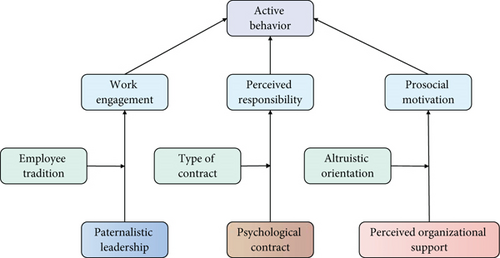
The K-means algorithm is a common objective function-based clustering technique. The K-means algorithm is a clustering algorithm that determines the interval between objects and uses that interval as the evaluation standard for object similarity. That is, the greater the similarity or similarity between two objects, the closer their distances are. The final results of this algorithm are compact and separate clusters made up of closely spaced objects, which are referred to as families. This method of clustering allows the number of clusters to be artificially set. That is, the k initial clustering centers will be accurately clustered into k classes, as well as the final clustering results. The algorithm uses the information cycle method, in which the nearby points are grouped into n clusters based on n cluster centers in each cycle of the information cycle. The average value of all points in each cluster should then be recalculated, and this will serve as the reference point for the next data cycle. The goal of the information cycle is to bring the reference point closer to all of the points in the real cluster, resulting in a more accurate clustering effect.
3.2. Influence Mechanism of Employee’s Active Behavior
With the rapid change of external environment and the increase of competitive pressure, the establishment of organizational competitive advantage depends not only on the direct management and command of employees but also on the active behavior of employees more and more. There is no consensus on the actual definition of employees’ initiative behavior between scientific research and enterprise management, which leads to different classifications of the dimensions of initiative behavior. For the organization, employees’ active behaviors include actively predicting the organizational environment, actively maintaining good relations with customers, actively seeking development opportunities, and actively solving potential problems in the organization.
Employees’ initiative behavior is a kind of spontaneous and predictable behavior based on the future. With the increasing complexity of the organizational environment, employees’ initiative behavior plays an increasingly important role in promoting the development and progress of the organization. Employees’ active behavior can not only promote employees’ own development but also effectively reduce the organization’s management cost and improve work performance. The personal factor that affects the behavior of the subject is mainly the positive or negative attitude evaluation of the individual to a certain behavior, and this factor is called attitude. Usually, people think that attitude can effectively predict the behavior will.
Active behavior is essentially an individual behavior driven by positive work motivation. Therefore, academic attention to active behavior increases with the deepening of work motivation research. Group behavior refers to the conscious and purposeful activities of the group, which is constant in both the network environment and the traditional enterprise environment. That is to say, at present, the network environment as an external environment affects the operation of group behavior and will not affect its core content. On the one hand, employees’ self-promotion can be realized; on the other hand, the development vitality of enterprises can be activated, and the upgrading and optimization of enterprises can be promoted. Therefore, how to stimulate employees’ initiative behavior is a common topic discussed by both academic and enterprise practice circles, and digging out the influencing factors of employees’ initiative behavior is the breakthrough to solve this problem.
Job motivation refers to a series of internal and external forces that stimulate behaviors related to job performance and determine the form, direction, and duration of these behaviors. Through the regression and combing of previous research on work motivation, the research on work motivation can be divided into three stages: (1) study on the work motivation of early reactivity, (2) study on cognitive work motivation in the middle term, and (3) research on the work motivation of later initiative. Traditional task performance and relational performance are classified according to the nature of work, which is a classification method that takes the activities of employees’ initiative behavior as the basis of classification and pays attention to employees’ own behavior, and can more effectively achieve employees’ psychological demands. Exploring individual’s active behavior from the perspective of performance characteristics is essentially a further exploration of work motivation theory and motivation, and this way can more accurately grasp employees’ behavior motivation. However, there are still some defects in exploring active behavior from this angle. The situational characteristics of active behavior are more worthy of attention, because active behavior is only an individual’s spontaneous transcendence of the job role in highly uncertain situations. The causality diagram of employees’ working process is shown in Figure 2.
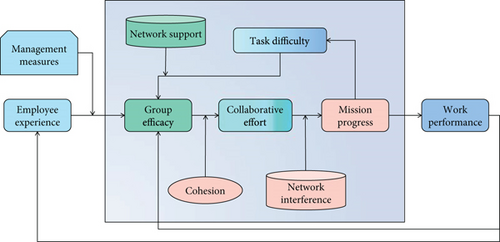
The effect of organizational climate on the organization and its employees is mainly reflected in its positive influence on employee satisfaction and organizational citizenship behavior. Individuals will not only respond to the environment and stimuli but will also actively identify external opportunities and threats and take appropriate actions, according to the motivational work motivation theory. From various perspectives, the individual’s active behavior will have different connotations. The definition of active behavior in this paper is based on the behavior pattern. Active personality has a wide range of effects as a stand-alone trait. People with an initiative personality can have a big impact on how their work is evaluated. People with an active personality can actively change their environment and use their skills to establish positive social relationships, resulting in positive feedback from superiors and improved work performance.
Self-identity theory explains the occurrence of individual initiative behavior from the perspective of individual’s pursuit of internal and external consistency and continuity. Self-identity promotes individual’s active matching and integration with others and environment through individual’s self-awareness and choice and provides a good explanation mechanism for active behavior under uncertain environment and future self-development. Generally speaking, the more positive people’s attitude towards a certain behavior, the stronger their behavior intention, and the greater the possibility of being transformed into direct behavior. Whether employees take job remodeling behavior depends on employees’ evaluation of the behavior. The more positive the evaluation, the easier it is to support the job remodeling behavior; otherwise, it is not. People with high initiative personality characteristics will promote the occurrence of active behavior, innovative behavior, and other behaviors, stimulate intrinsic motivation, actively change the surrounding environment, strive to seek opportunities, and find more effective solutions, thus producing better work results. People with active personality traits will have higher satisfaction, actively create the relationship with organizations and environment, and thus stimulate the generation of higher active behaviors.
3.3. Algorithm Realization of Data Mining Model
Fuzzy clustering method is to classify and analyze objects with unclear classification boundaries in the real world. It is a classification method of multivariate statistics “birds of a feather flock together.” Select benchmarks with different performance levels from similar objects or similar objects, and then calculate the similarity or affinity between the judged objects and performance benchmarks, so as to make the evaluation results. Clustering is an analysis process that discovers the internal relations or similarities in data and classifies the target data sets into different categories. There is a great similarity between the data in the same category, but there is a great difference between each category.
In the motivational learning strategy, α and β are external parameters of the system, which can be defined by the user to determine the strength of the adjustment strategy.
For analysts, it is very useful to reorganize semistructured data into structured data that can be systematically identified and at the same time apply it to the analysis process to form an intuitive statistical chart. This process is a comprehensive analysis of the whole process of data cleaning, classification, and clustering. Process refers to the changes experienced by the system in a period of time, and all changes of the system are directly or indirectly caused by the process. Physical state is generally described by a group of individuals, their properties, and relationships among individuals. This description is static and can represent the system state at different times. The process intuitively depicts the evolution of the system, and the essence is the function of individual parameters that change the state of a certain system over time.
The greater the proximity, the closer the observation is to the optimal value and the farther it is from the worst value, and the evaluation result is excellent. The smaller the proximity, the farther the observation is from the optimal value and the closer it is to the worst value, and the evaluation result is inferior. In practice, the management policies of enterprise managers will change with the change of time. However, the cycle of this change is too long, and many changes of management policies are made only because the previous management methods are inconsistent with the reality and not conducive to the development of enterprises. However, the existence of early warning mechanism can play a precautionary role. In the process of occurrence, there is a quantity space composed of several ordered elements corresponding to discontinuous changes, and the boundary is the limit point of these elements. Once the sequence between quantities changes, it means the end of one process and the beginning of another.
In data filtering, the monitored data are stored in the same database in a unified way, and useful information is filtered by information retrieval technology. According to the actual demand, the classification rule template is formulated, and the information matching the classification rule template is executed according to the preset conditions through analysis tools. Finally, the execution results are stored in the analysis database. The process of data mining is a process of continuous feedback. Only through the feedback of results can we find out the problems that may occur in the process of data mining, such as low data quality and mismatch between model and business. Through feedback, timely adjust the data collection methods and sources, and constantly revise the mining model, so as to improve the practicability and effectiveness of data mining technology in practical business.
4. Result Analysis and Discussion
The vast majority of information in the Internet is semistructured or multistructured data. Among these data, useful information is mixed with a large amount of noise or useless data, which makes it difficult for the system to understand and analyze. When faced with a large amount of complicated data, it is impossible to judge manually. If you want to analyze semistructured or multistructured data, you need a set of complex rule patterns embedded in the system. When the system reads the information, it can automatically judge and identify useful information.
Test the moderating effect of contract type, and analyze whether contract type moderates the influence of three kinds of psychological contract satisfaction (relationship contract satisfaction, transaction contract satisfaction, and balance contract satisfaction) on active behavior by using the method of hierarchical regression after controlling gender, age, and length of service. In order to avoid the multicollinearity problem, independent variables and regulatory variables are treated as standard in the test of regulatory effect. The data is initially processed so that all evaluation items are distributed in the range of [0,1]. In this paper, the original data is compared with the full score for initialization adjustment. The initialized employee performance indicators can form a data matrix in the range of [0,1], which is convenient to form the corresponding membership function. After controlling gender, age, education level, industry experience, and length of service, this paper analyzes whether tradition regulates the influence of paternalistic leadership on active behavior. The moderating effect of tradition on the relationship between benevolent leadership and active behavior is shown in Figure 3.
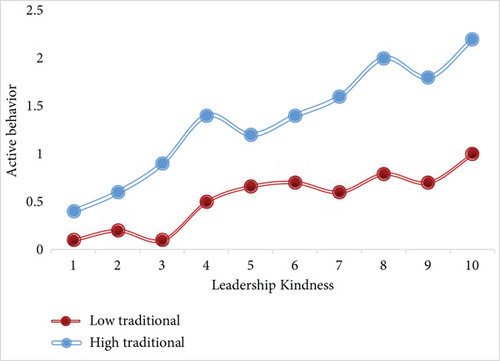
As can be seen from the Figure 3, compared with employees with low tradition, benevolent leadership has a greater positive impact on employees with high tradition. The moderating effect of tradition on the relationship between authoritarian leadership and active behavior is shown in Figure 4.
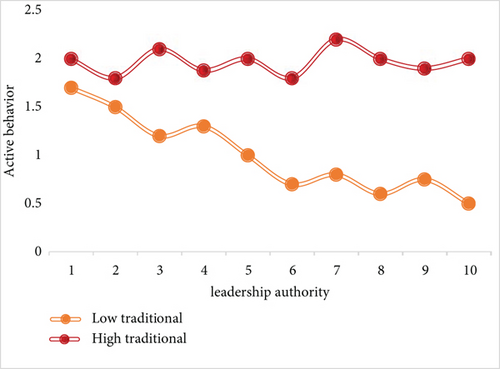
Authoritarian leadership, as shown in the graph, has a greater negative impact on active behavior among employees with low tradition than among employees with high tradition. Find all of the high-frequency data items in the database using an iterative method of information search. By layer-by-layer search and iteration, the basic principle is to investigate unknown data item sets with known data item sets. The causality order method solves causality without feedback, whereas causality with feedback necessitates the use of more complicated methods. Of course, people’s learning abilities and the interaction of group behavior both influence whether or not the crowd system provides feedback. The problem is simplified here to allow for a preliminary assessment of the qualitative relationship between variables in the crowd system. Figure 5 shows a data-driven interactive diagram of contract types and balanced contracts.
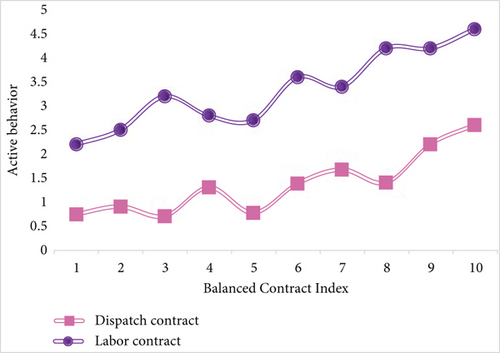
It can be seen from Figure 5 that, compared with the employees in the labor dispatch contract, the balance contract has a greater positive impact on the active behavior of the employees in the formal labor contract. In practical work, the tasks faced by employees are relatively complicated, the amount of information increases, and more cooperation is needed. Therefore, the work of employees in the enterprise environment is actually a multistage cooperation process. In this process, employees continue to complete their tasks, accumulate experience, and enhance their emotions. Work attitude evaluation index is a kind of feedback to employees’ work attitude in the process of work and a supplement to work results. Some employees may have a temporary low work output due to experience and other reasons, but we cannot deny his efforts at work, which may be the accumulation of future performance improvement. Therefore, through the evaluation of work attitude, employees’ contribution can be evaluated accordingly, which is an important part of reasonably improving the performance evaluation system. In the process of simulation, the behavior of employees is always in a state of change. The results of individual simulation are shown in Figure 6.
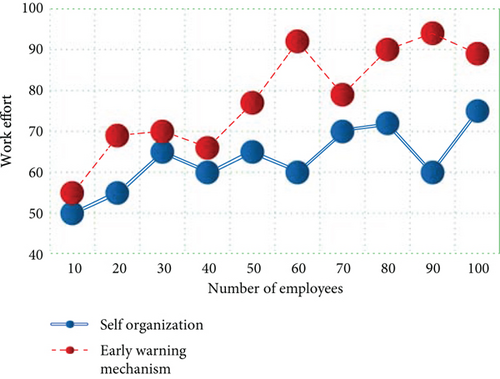
From the simulation results, it can be seen that the behaviors of employees are not only caused by the environment or management policies but also the complexity that emerges in the normal operation of enterprises mainly comes from the employees themselves and the internal mechanism and structure of enterprises. Employees’ behavior has its own rules and ways of evolution, but letting it evolve will lead to the variability of employees’ behavior. Active behavior affects interaction as shown in Figure 7.

It can be seen from Figure 7 that perceived organizational support has a greater positive impact on the active behavior of employees with high altruism orientation than employees with low altruism orientation. In the information search system, the core dictionary is a special database, and its maximum size is consistent with that of the general database. With the continuous improvement of the recall and precision of the core dictionary, it has become an important means to realize multilanguage search and intelligent retrieval, that is, indexing the hot words and keywords extracted during retrieval, in order to provide relevant indexing words for the next retrieval. It is necessary to use the correlation analysis method of data mining to carry out causal correlation analysis between competence, quality, and performance, so as to obtain a more scientific performance forecast. Because the ability and quality will grow with the growth process by acquiring knowledge and accumulating experience, it is a continuous process. Therefore, when mining this kind of index data, it is often to analyze and evaluate a time point or time period, but the real-time evaluation function cannot be realized. The purpose of automatic clustering using data model is to ensure that the results after clustering are within the range of attention targets, enhance the relevance of attention points, and reflect the useful value of data. To prove the effectiveness of this algorithm, we compare it with CNN algorithm and traditional NN algorithm. The result is shown in Figure 8.
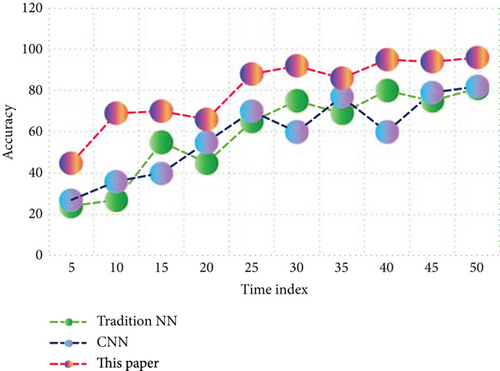
It can be seen that this algorithm is superior to the other two algorithms, and its accuracy is the highest. In the research object of this paper, this algorithm has been well used. In order to facilitate analysis and comparison, it is necessary to show the same trend for the evaluation indexes. The scheme with better performance under any attribute should have larger attribute value after transformation; that is, the maximum value of the same attribute is the best among all observations. For example, the greater the work output, the better the performance. However, the less materials are consumed, the better the economy is, so the more materials are consumed, the lower the attribute value is. Using the method of data processing, we can quickly find out the abnormal data of network behavior among a large number of network behavior data. At the same time, we can use the association rule to explore the relationship between the data and gather the similar data together, so as to get useful data and get comprehensive performance evaluation of employees’ performance. The final result of employee performance can be obtained by multiplying the weight vector with the evaluation score of the first-class index of employees.
The experiments show that the algorithm in this paper has certain advantages and high accuracy. In practice, the organization should give consideration to long-term employment relationship and performance reward system. The influence of psychological contract satisfaction on employees’ active behavior will be interfered by the type of contract. If the organization needs to make employees show more active behaviors, it should eliminate the influence differences caused by different contract types, carefully apply labor dispatch contracts, and use more formal contracts.
5. Conclusions
Data mining itself is a part of statistical analysis, which is very suitable for all-round and multilevel data processing. It is also conducive to the openness and fairness of performance appraisal, so that more people can participate in it and constantly improve the initiative of employees. At present, most employees’ thinking still stays in the top-down mandatory and mandatory management mode in the past, their awareness and evaluation of active work is not high enough, they are not aware of the great value brought by active work, and they rely more on organizational norms to give employees a certain degree of support to promote their work. Therefore, enterprises should pay attention to the value potential that employees’ active behaviors can create for enterprises and strengthen the support of subjective norms to guide employees’ active behaviors. In this paper, the influence of employee’s characteristic factors on work initiative behavior is studied by one-way ANOVA. And analyze the influencing factor model of the new generation employees’ work initiative behavior. The simulation results show that the model is more in line with the reality, which is conducive to the analysis of the influence mechanism of enterprise managers on employees’ active behaviors and the correct prediction of employees’ behaviors. Implement correct management policies to adapt to the variability of external environment. Because the author’s research is limited, this paper simplifies many problems in the process of simulation. Although it does not affect the method and correctness of the model, there is still a big gap compared with the real situation. The follow-up work of this paper is to fully consider various reasonable variable factors and strive to build a better model.
Conflicts of Interest
The authors do not have any possible conflicts of interest.
Acknowledgments
This study was supported by the National Natural Science Foundation of China (72102251) and Science and Technology Development Program of the Department of Science and Technology of Guangdong Province (KTP20210319).
Open Research
Data Availability
The data used to support the findings of this study are included within the article.




